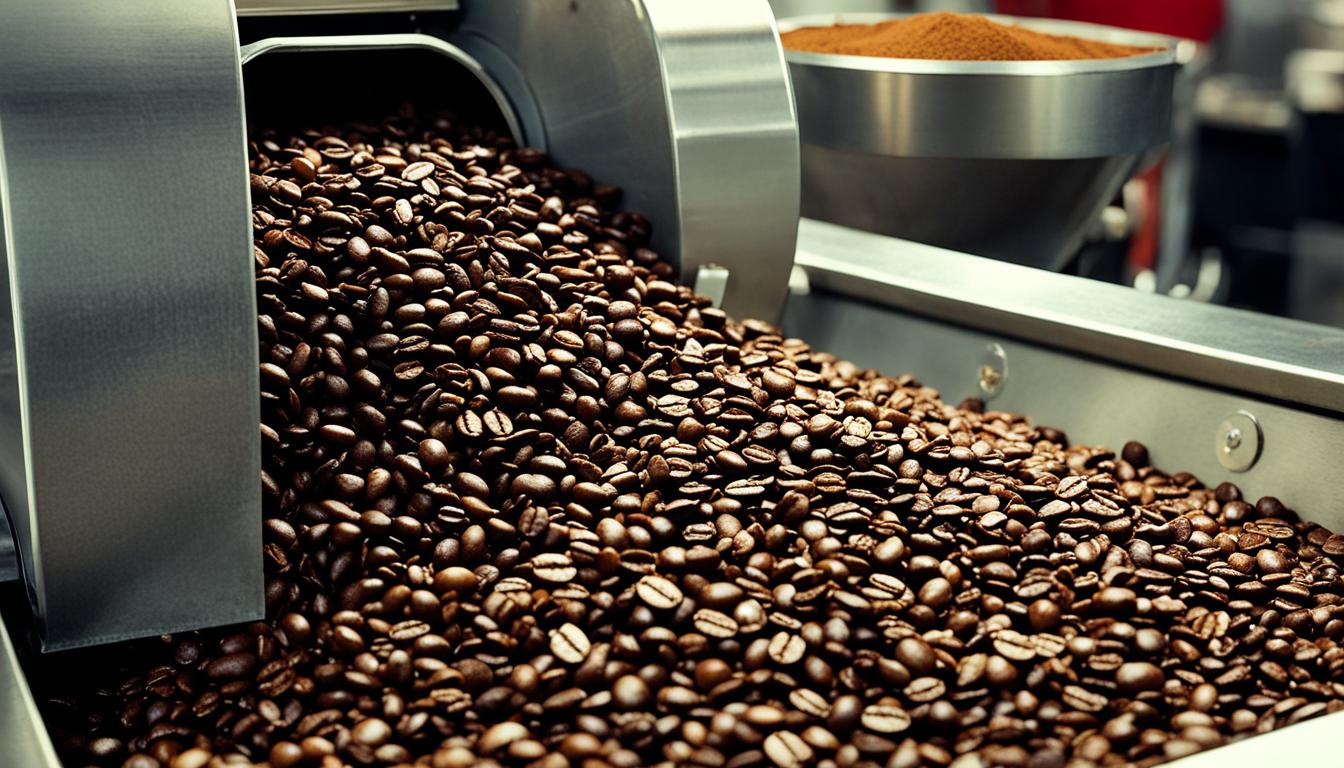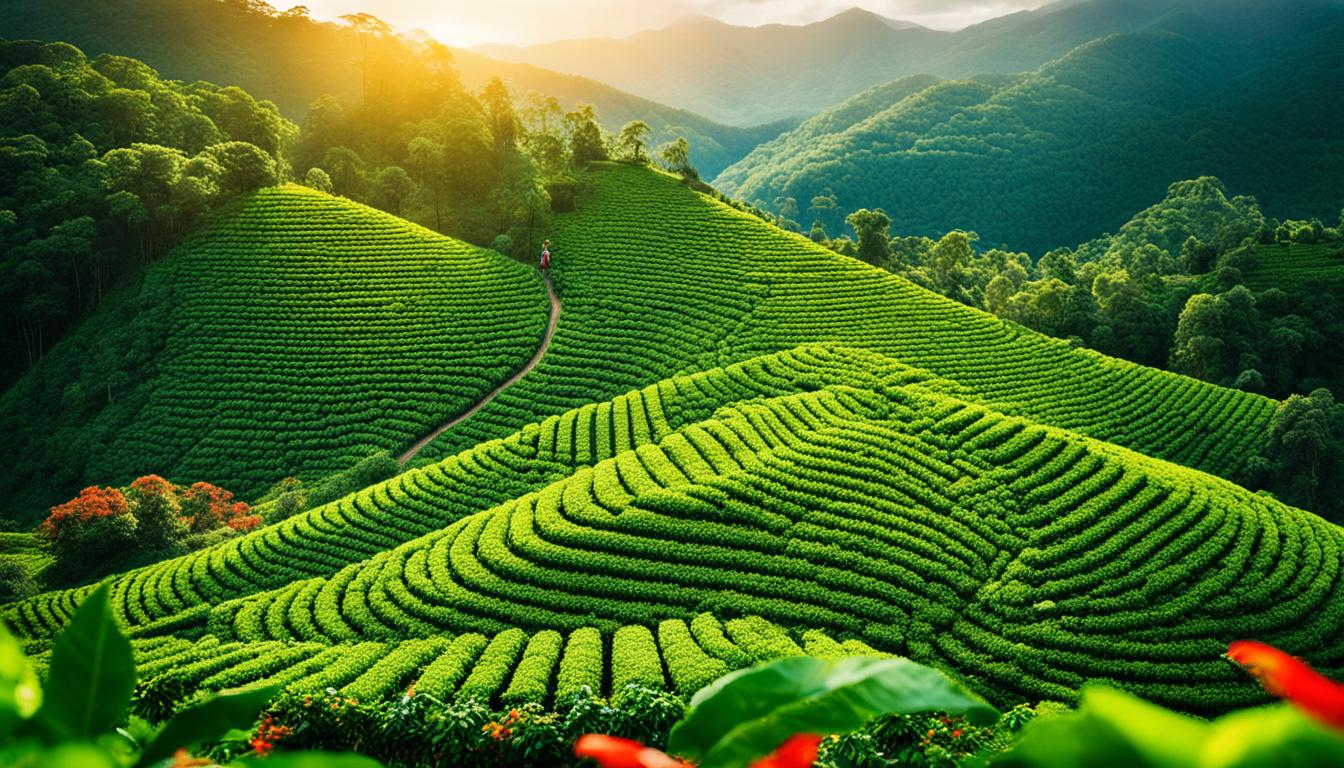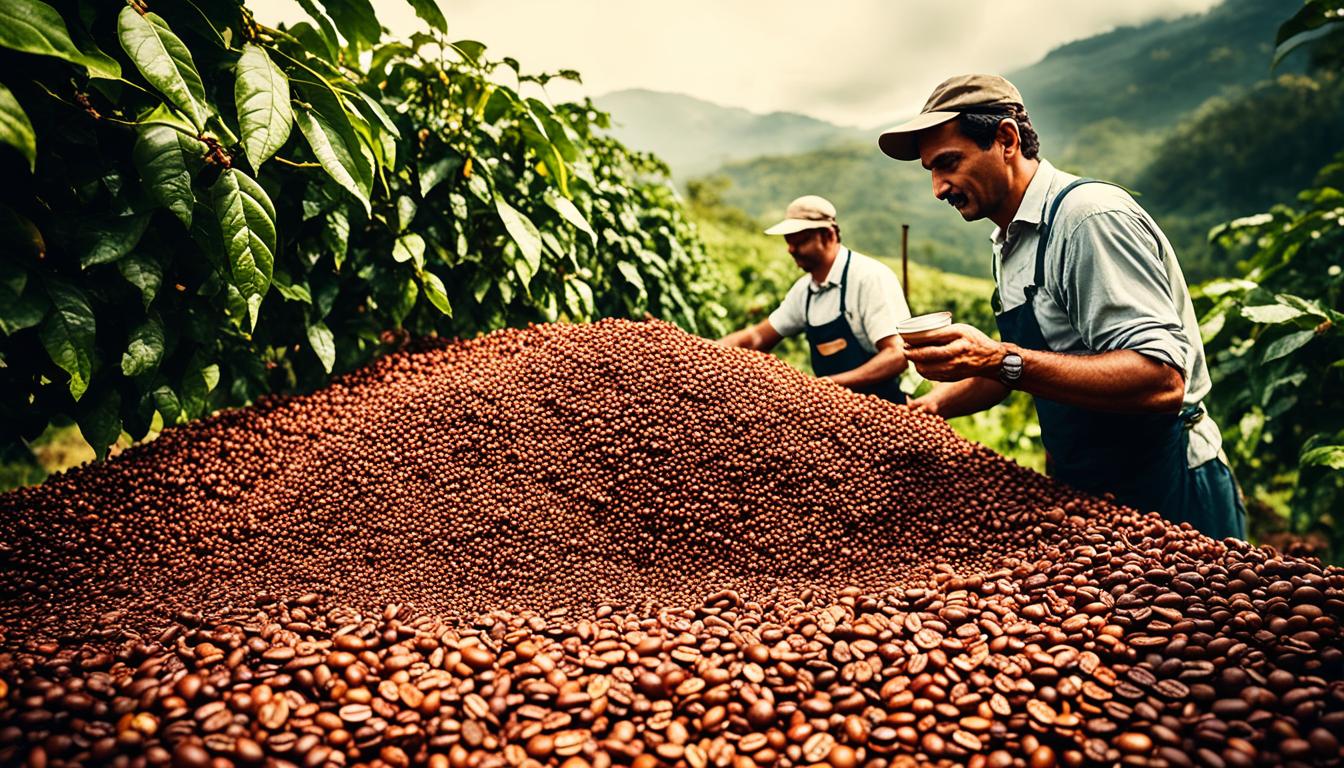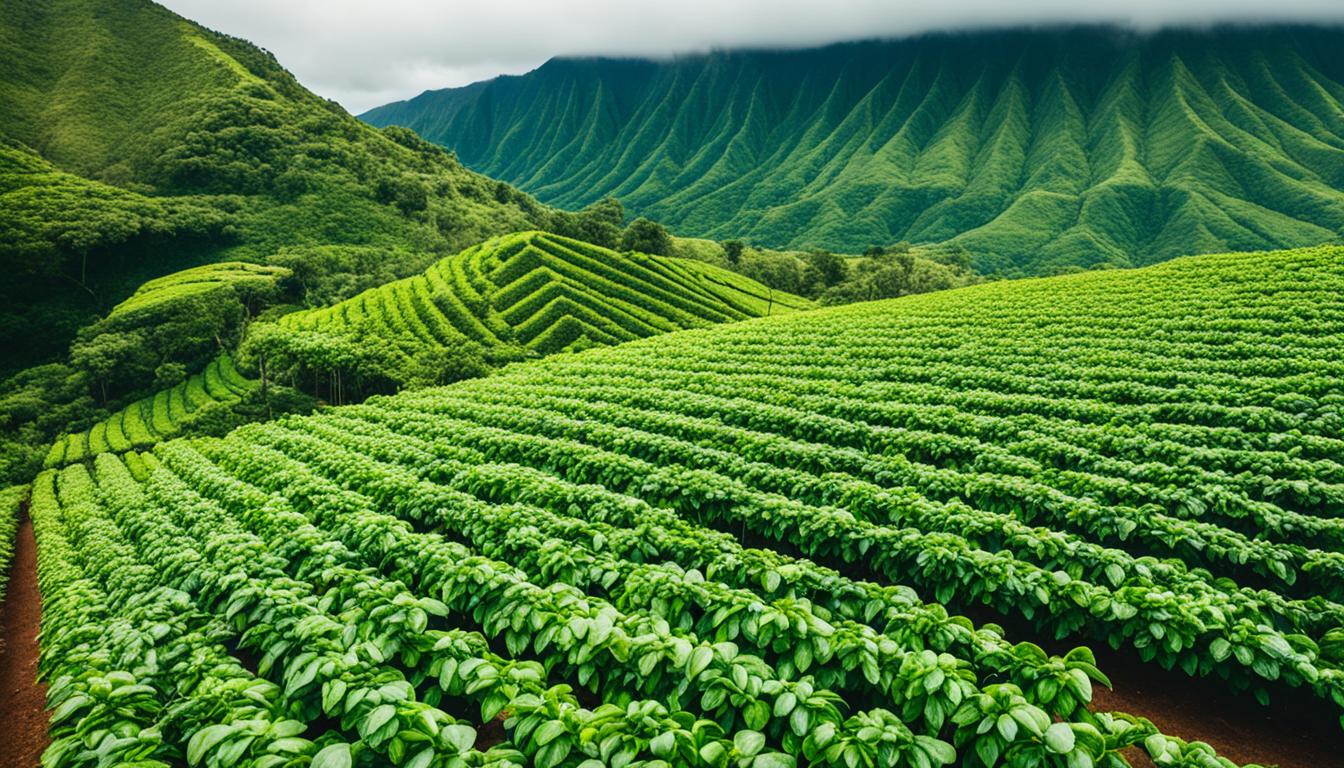Welcome to our guide on coffee’s journey from bean to cup. In this article, we will explore the fascinating process of coffee production, from the cultivation steps to the final preparation of your favorite cup of joe. Whether you are a coffee enthusiast or simply curious about how your morning pick-me-up is made, we’ve got you covered.
Have you ever wondered how that fragrant and flavorful cup of coffee is created? It all starts with the coffee bean, which goes through multiple stages before reaching your cup. From planting the seed and harvesting the cherries to processing, roasting, grinding, and brewing, each step is carefully executed to ensure the highest-quality coffee.
The journey begins in coffee plantations where the beans are cultivated. We will explore the various methods of coffee cultivation, including the different harvesting techniques and processing methods that contribute to the distinct flavors and aromas. Additionally, we will delve into the art of roasting, where the raw beans are transformed into the familiar brown beans that we all know and love.
Once the beans are roasted, they need to be ground to the appropriate size based on the brewing method you choose. We will discuss the different grinding techniques and brewing methods, highlighting the importance of grind size and brewing temperature in extracting the optimal flavors from the coffee.
Throughout this journey, we will touch on the concept of specialty coffee, which undergoes meticulous cultivation and processing to produce exceptional and unique flavors. We will also emphasize the joy of tasting and experiencing different coffees, whether you prefer a dark roast or a delicate single-origin brew.
Join us as we uncover the secrets behind each step of the coffee production process, revealing the art and science that goes into every cup. Get ready to sip, savor, and appreciate the remarkable journey that brings coffee from bean to cup.
Key Takeaways:
- Coffee goes through multiple stages, from planting the seed to brewing the final cup.
- The cultivation and processing techniques used contribute to the unique flavors and aromas of coffee.
- Roasting plays a crucial role in transforming green beans into aromatic brown beans.
- Grinding and brewing methods determine the extraction of flavors from the coffee.
- Specialty coffee offers exceptional flavors and is the result of meticulous cultivation and processing.
Planting and Harvesting
Coffee planting is the first step in the journey of coffee production. It all begins with coffee seeds, which are carefully planted in shaded nurseries. These nurseries provide the optimal conditions for the seeds to germinate and grow into healthy coffee seedlings.
After a few years, these seedlings develop into coffee trees and start bearing fruit in the form of coffee cherries. These cherries go through a beautiful transformation as they ripen, turning from green to bright red when they are ready to be harvested.
The harvesting of coffee cherries is a crucial stage in the coffee production process. There are two main methods used for harvesting: strip picking and selective picking.
Strip picking involves removing all the coffee cherries from the tree at once. This method is often used for large-scale coffee plantations where efficiency is key. However, it can lead to a mixture of ripe and unripe cherries, affecting the overall quality of the coffee.
Selective picking is a more meticulous approach that involves handpicking only the ripe coffee cherries. Skilled coffee harvesters carefully select each cherry, ensuring that only the best and ripest ones are harvested. This method guarantees the highest quality coffee but requires more time and manual labor.
To give you a better understanding of the differences between strip picking and selective picking, let’s see a comparison:
| Harvesting Method | Advantages | Disadvantages |
|---|---|---|
| Strip Picking | – High efficiency for large plantations – Quick harvesting process |
– Mixture of ripe and unripe cherries – Potential lower quality |
| Selective Picking | – Highest quality coffee – Careful selection of ripe cherries |
– Time-consuming – Manual labor-intensive |
Both strip picking and selective picking methods have their place in the coffee industry, depending on the scale of production and desired quality. However, selective picking is often favored for specialty coffee production, where attention to detail and quality is paramount.
Processing and Drying
After harvesting, the coffee cherries undergo a crucial step known as processing. This step plays a significant role in determining the final flavor and quality of the coffee. There are two main methods used for processing coffee: the dry method and the wet method.
In the dry method, the harvested cherries are spread out on large surfaces, such as patios or raised beds, to dry naturally under the sun. This process can take several weeks and requires regular turning of the cherries to ensure even drying. The natural sugars within the cherries ferment during this process, imparting unique flavor characteristics to the beans. The dry method is commonly used in regions where there is an abundance of sunlight and a low risk of rain.
In contrast, the wet method involves removing the outer skin and pulp of the coffee cherries before drying the beans. After harvesting, the cherries are pulped using specialized machinery to separate the outer layers. The beans are then sorted by weight using water, where the heavier beans are considered higher in quality. The selected beans are transferred to fermentation tanks where they undergo fermentation, which further enhances the flavor profile. This method is often preferred in regions with high humidity and rainfall.
The processing method used can greatly impact the final cup of coffee. The dry method tends to produce coffee with pronounced fruity and wine-like flavors, while the wet method results in a cleaner and brighter cup.
After processing, the beans need to be dried to the appropriate moisture level. This step is crucial to prevent the growth of mold or other contaminants. The drying process can take place on patios, elevated drying tables, or using mechanical dryers. It is important to monitor and control the drying time and temperature to achieve optimal results.
Once the beans reach the desired moisture content, they are ready to be milled. Milling involves removing the parchment layer that surrounds the beans, revealing the green coffee beans. The beans are then sorted and graded based on size and quality before being packed and transported for further processing or roasting.
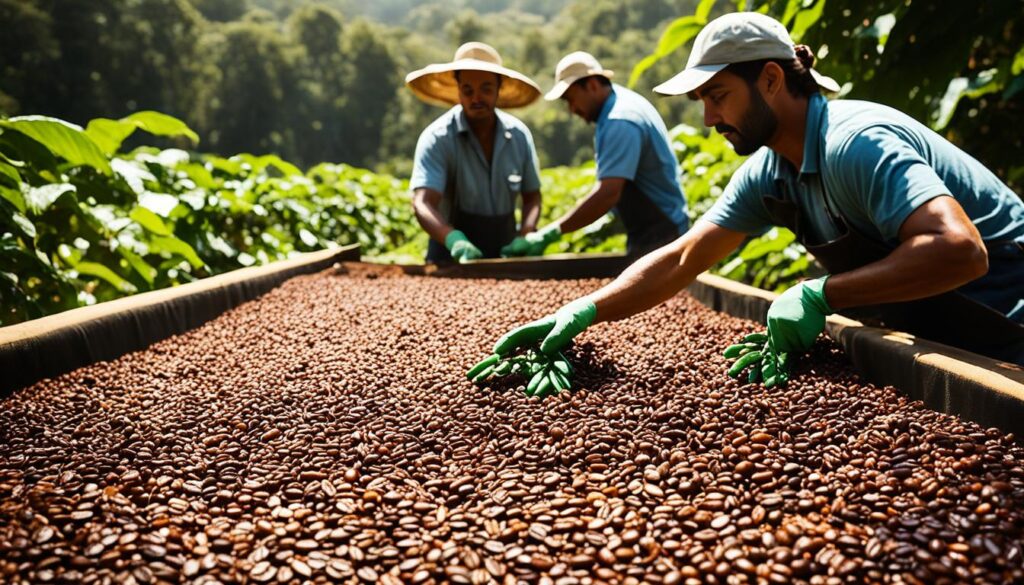
The image above illustrates the drying process of coffee beans, an essential step in coffee production where moisture is carefully reduced to ensure the best quality beans.
Roasting
Roasting is a critical step in the coffee production process. It transforms the green coffee beans into aromatic brown beans that we recognize. The roasting process involves heating the beans to a specific temperature and duration, which affects the final flavor and aroma of the coffee. Different roast levels, such as light, medium, and dark, offer different profiles and intensities.
Roast Levels
Coffee roasting determines the roast level, which plays a vital role in the coffee’s taste. Each roast level brings out distinct flavors and aromas. Let’s take a closer look at the different roast levels:
| Roast Level | Description | Characteristics |
|---|---|---|
| Light Roast | Tan or light brown color with no oil on the surface | Delicate acidity, pronounced fruity and floral notes, higher caffeine content |
| Medium Roast | Medium brown color with a light sheen of oil | Well-balanced acidity, subtle sweetness, rounded flavors |
| Dark Roast | Dark brown to almost black with visible oil | Lower acidity, rich and bold flavors, bittersweet chocolate and caramel notes |
Choosing the right roast level depends on your personal preference and the desired flavor profile. Lighter roasts emphasize the coffee’s origin, showcasing the unique characteristics of specific regions. Medium roasts strike a balance between acidity and body, while dark roasts offer a robust and intense experience.
The Roasting Process
The roasting process requires precision and expertise to bring out the optimal flavors. Here are the key steps involved:
- Green Coffee: The process begins with high-quality green coffee beans sourced from various regions around the world.
- Preheating: The roasting machine is preheated to the desired temperature.
- Loading the Beans: The green coffee beans are loaded into the roasting drum or chamber.
- Roasting: The beans are heated gradually, reaching different temperature milestones based on the desired roast level. As the temperature increases, chemical reactions occur within the beans, leading to the development of flavors and aromas.
- Cooling: Once the desired roast level is achieved, the beans are rapidly cooled to cease the roasting process and preserve their flavors.
- Resting: After roasting, the beans need to rest for a period to allow the flavors to fully develop.
Master roasters rely on their knowledge, experience, and sensory skills to ensure each batch of roasted coffee meets the highest standards of quality and taste.
Roasting plays a fundamental role in unlocking the unique flavors and aromas of coffee. By carefully controlling the roast level and following a precise roasting process, coffee roasters create the perfect blend of taste and aroma that coffee enthusiasts savor in every cup.
Grinding and Brewing
Once you have selected your perfect coffee beans, it’s time to prepare them for brewing. Grinding the beans to the appropriate size is essential in ensuring a flavorful and aromatic cup of coffee. The right grind size depends on the brewing method you’ll be using. Whether it’s a French press, pour-over, or espresso, each method requires a specific grind size to achieve optimal extraction.
Coffee grinding is the process of breaking down the beans into smaller particles. The size of the grind determines the rate of extraction during brewing. A finer grind allows for a greater surface area of the coffee particles to come into contact with hot water, resulting in a stronger and more intense flavor. Conversely, a coarser grind produces a milder and smoother cup of coffee.
When it comes to coffee brewing methods, each has its own recommended grind size:
French Press: For this method, a coarse grind is ideal. The larger grounds will be steeped in hot water for an extended period, creating a full-bodied and robust brew.
Pour-Over: With pour-over methods like the V60 or Chemex, a medium grind is recommended. This allows for a balanced extraction, resulting in a clean and vibrant cup of coffee.
Espresso: Espresso requires a fine grind to achieve the proper extraction. The finely ground coffee is tightly packed into the espresso machine’s portafilter, and hot water is forced through the grinds under pressure, producing a concentrated and bold espresso shot.
In addition to grind size, brewing temperature plays a crucial role in extracting the flavors from the coffee. The ideal brewing temperature can vary depending on the beans and the desired flavor profile. Generally, a temperature between 195°F (90°C) and 205°F (96°C) is recommended for most brewing methods. This range ensures optimal extraction without over-extraction or scorching the coffee.
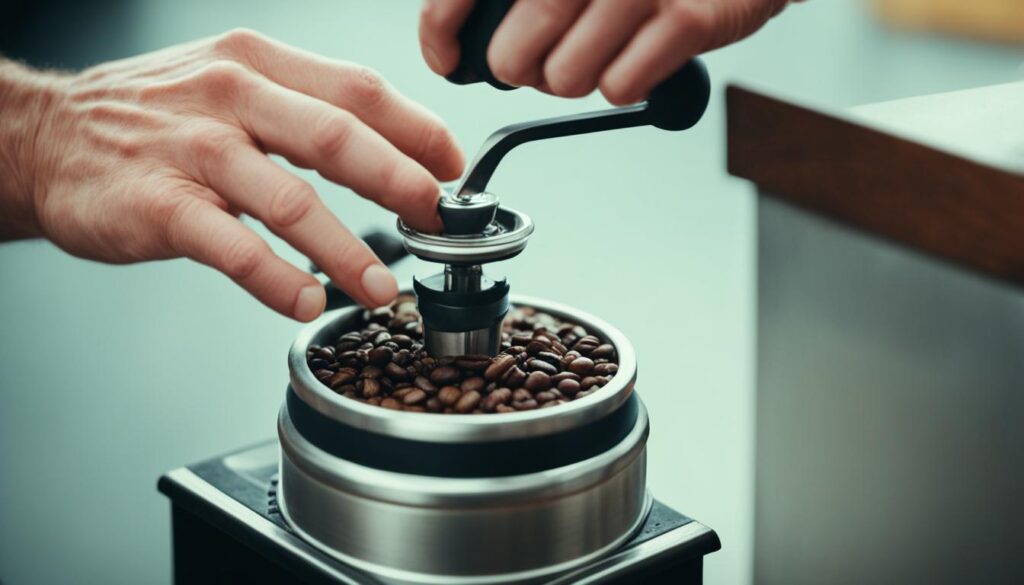
| Brewing Method | Grind Size | Brewing Temperature |
|---|---|---|
| French Press | Coarse | 195°F-205°F (90°C-96°C) |
| Pour-Over | Medium | 195°F-205°F (90°C-96°C) |
| Espresso | Fine | 195°F-205°F (90°C-96°C) |
Conclusion
Summarizing the captivating coffee journey from bean to cup, we witness the meticulous cultivation and processing that specialty coffee undergoes, resulting in exquisite and unparalleled flavors. Through the act of coffee tasting, we are able to fully immerse ourselves in the art and science that goes into every cup. Whether you prefer the boldness of a dark roast or the intricate nuances of a delicate single-origin brew, the remarkable journey of coffee never fails to delight coffee lovers worldwide.
From the initial planting of coffee seeds to the final step of brewing, each phase contributes to the creation of a truly exceptional coffee experience. Specialty coffee sets itself apart by embracing a commitment to excellence at every stage, from carefully selecting the finest coffee cherries to meticulous processing techniques that help unlock the unique characteristics of each bean. The result is an extraordinary sensory encounter that tantalizes the taste buds and ignites the senses.
By engaging in coffee tasting, we gain a deeper appreciation for the craft and expertise that goes into every aspect of the coffee journey. Each sip allows us to embark on a sensory adventure, exploring the intricate flavors and aromas encapsulated in our cup. Whether it’s the sweet notes of caramel and chocolate or the vibrant acidity of fruit, coffee tasting is an opportunity to pause, savor, and connect with the rich and diverse world of specialty coffee.
As we reflect on the remarkable coffee journey from bean to cup, it’s impossible not to be enthralled by the passion and dedication of the individuals and communities who bring us this beloved beverage. Coffee is not just a drink; it’s a symbol of connection, culture, and shared experiences. So, let us raise our cups and toast to the extraordinary world of coffee, where every sip is a celebration of craftsmanship, tradition, and the unifying power of this remarkable beverage.
FAQ
What are the main steps in the coffee production process?
The main steps in the coffee production process include planting and harvesting, processing and drying, roasting, and grinding and brewing.
How are coffee cherries harvested?
Coffee cherries can be harvested through strip picking, where all the cherries are removed at once, or selective picking, where only the ripe cherries are harvested, typically by hand.
What are the two main methods of coffee processing?
The two main methods of coffee processing are the dry method, where the cherries are spread out to dry in the sun, and the wet method, where the cherries are pulped and then separated by weight and fermented in tanks.
What happens after coffee cherries are processed?
After processing, the beans are dried to the appropriate moisture level before being milled to remove the parchment layer.
What is the roasting process in coffee production?
The roasting process involves heating the beans to a specific temperature and duration, which transforms the green coffee beans into aromatic brown beans. Different roast levels offer different flavor profiles and intensities.
How should coffee beans be ground for brewing?
Coffee beans should be ground to the appropriate size based on the desired brewing method. Different methods, such as French press or espresso, require different grind sizes.
What role does brewing temperature play in coffee extraction?
Brewing temperature plays a crucial role in extracting the flavors from the coffee. Proper grinding and brewing techniques ensure the best flavors and aromas are achieved.
Why is specialty coffee considered unique and exceptional?
Specialty coffee undergoes meticulous cultivation and processing, resulting in unique and exceptional flavors. Tasting specialty coffee allows us to appreciate the art and science behind each cup.

